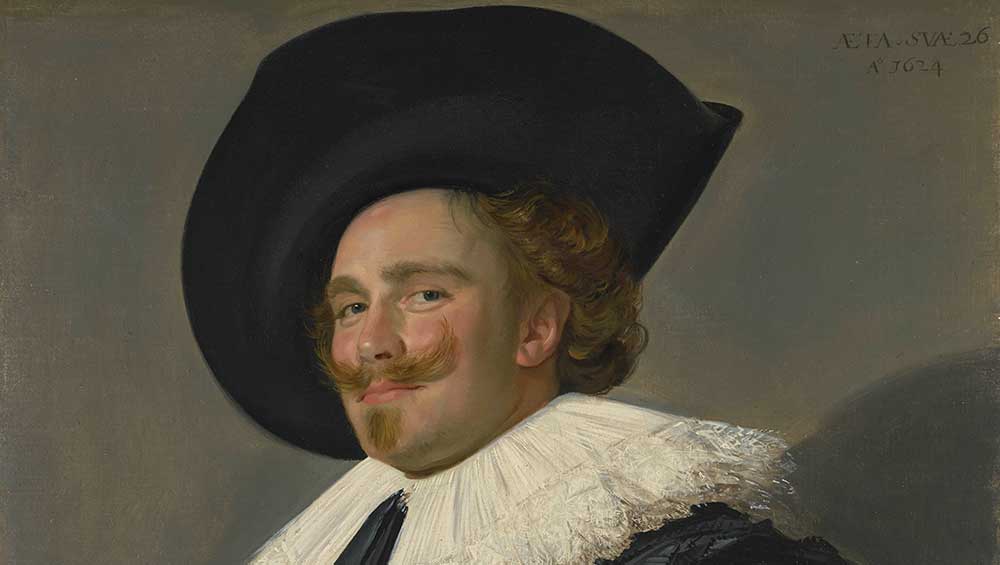
Frans Hals. The Laughing Cavalier, 1624 (detail). Oil on canvas, 83 x 67 cm. © Trustees of the Wallace Collection, London.
The National Gallery, London
30 September 2023 – 21 January 2024
by ANNA McNAY
Who doesn’t know those twinkling brown eyes and that cheeky, smiling moustache of the cocksure, lavishly clad man with the huge hat (the bigger the hat, the greater the importance), a long-standing favourite on the walls of Hertford House, home to the Wallace Collection? Frans Hals’s The Laughing Cavalier (1624) was purchased by the Marquess of Hertford at an auction in Paris in 1865 for 51,000 francs – 11 times the price paid by the previous owner. In securing the painting for his collection, he beat the National Gallery and James de Rothschild. The acquisition was central to the rediscovery of the Dutch Golden Age painter Hals (1581/5-1666) and yet remains the sole work for which he is widely known, despite never having left the walls of the Wallace Collection – that is, until now. Currently, it is starring in an exhibition at the National Gallery, London, curated in partnership with the Rijksmuseum, Amsterdam, and the Gemäldegalerie, Staatliche Museen zu Berlin (to which it will tour), with the special collaboration of the Frans Hals Museum, Haarlem.
The identity of the sitter is unknown, and his moniker is misleading, since he is neither laughing (apart, perhaps, from inwardly, betrayed only by his eyes) nor a cavalier. Theories, however, abound. One such, put forward by the independent art historian Clare Ford-Wille, in a recent lecture for ARTscapades, claims that the fact that he is facing towards the left, which, in Hals’s numerous pendant portraits is always the wife’s position, suggests he is unmarried – perhaps even looking for a wife – and that the arrows and flaming torches in the detail of his jacket also point to this, with the implication of his wearing his heart on his sleeve. I am not convinced by this, however, since while this may be the female position in Hals’s pendant portraits, there are plenty of other solo portraits of men looking to their left, including Portrait of a Man, possibly Nicolaes Pietersz Duyst van Voorhout (c1637) in the very same room.
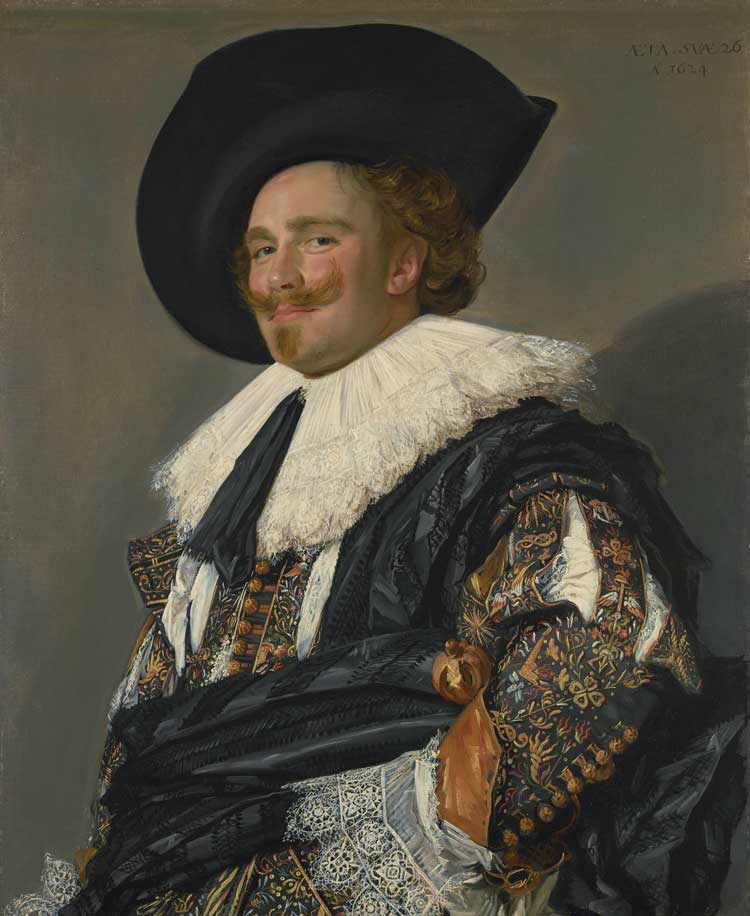
Frans Hals. The Laughing Cavalier, 1624. Oil on canvas, 83 x 67 cm. © Trustees of the Wallace Collection, London.
The non-laughing, non-cavalier hangs in the second of eight rooms, curated thematically, while also largely chronologically, bringing together 50 works from an impressive array of lenders. Curator Bart Cornelis describes looking at a painting by Hals as “almost a visceral experience”, “so immediate and so direct”. Certainly, this rare opportunity to meet the wider cast of Hals’s oeuvre offers fascinating insight into the fashions and customs of his time, as well as his revolutionary experimentation and development as a portraitist.
Very little is known of Hals’s life, and he seemingly burst on to the scene fully fledged. His earliest surviving portraits, of which four from the 1610s are on show here, are deemed too skilful to be his earliest attempts. His youth and training are a mystery, although it is thought he may have studied under the Flemish painter Karel van Mander (1548-1606). He was born in Antwerp, but his parents fled with him to Haarlem after the town was recaptured by the Spanish in 1585.
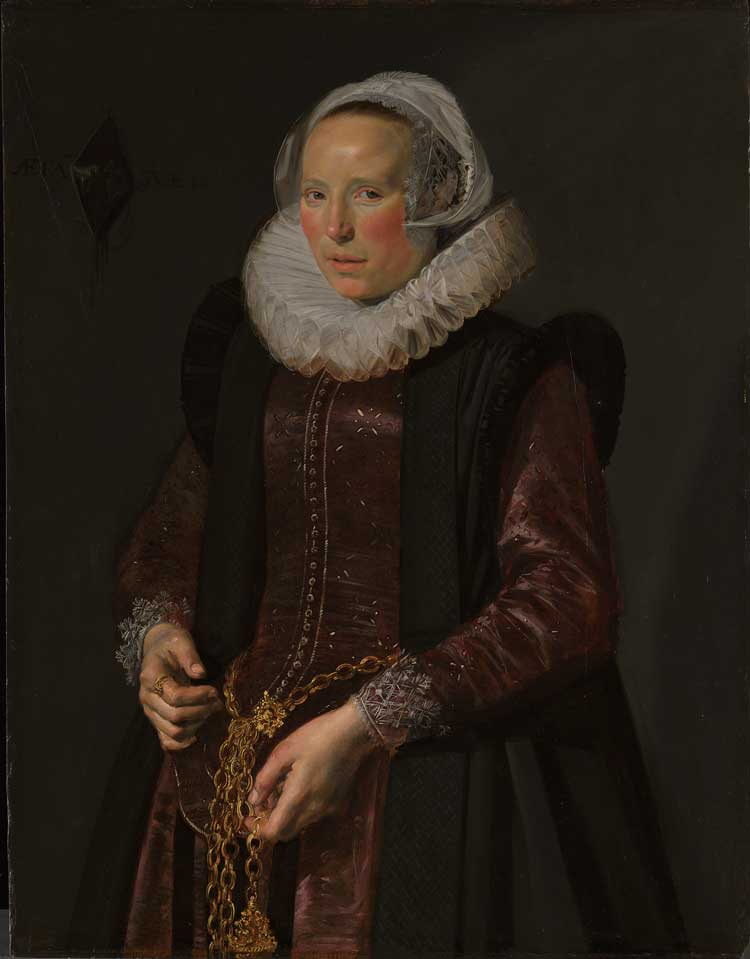
Frans Hals. Portrait of a Woman standing, c1612. Oil on wood, 94.2 x 71.1 cm. The Devonshire Collections, Chatsworth. © The Devonshire Collections, Chatsworth. Reproduced by permission of Chatsworth Settlement Trustees.
While the first pair of pendant portraits, Portrait of a Man holding a Skull and Portrait of a Woman Standing (both 1612), comprises fairly formulaic poses, we can already marvel at the intricate yet confident brushwork suggesting the crisp layers of the man’s starched cuffs and ruff – the latter being the height of fashion – and the luminous flesh tones, which bear a Rubenesque quality. The woman, most likely, is wearing her wedding dress. The most outstanding work in this first room, however, is Portrait of Catharina Hooft with her Nurse (1619-20), which boasts absolutely beautiful lacework, resplendent embroidery on the two-year-old’s dress, and beguiling smiles on both faces, with a dab of white highlighting suggesting a moistness on the child’s lips. This ability to capture expressions with such affection and earnestness is evidently one defining feature of Hals’s work.
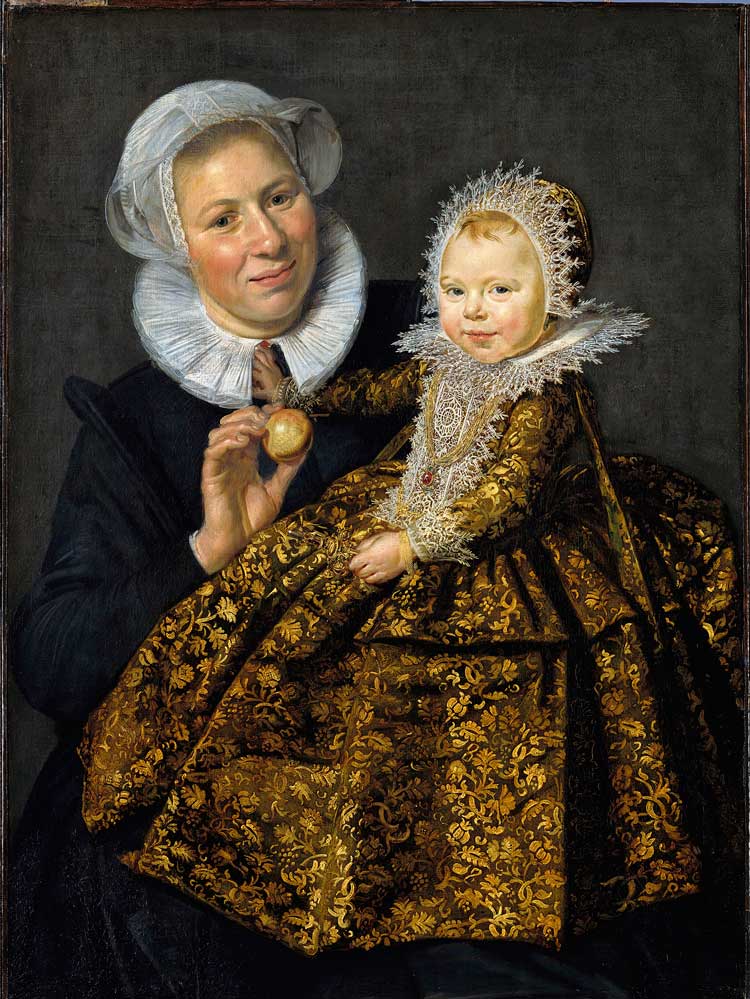
Frans Hals. Portrait of Catharina Hooft with her Nurse, 1619–20. Oil on canvas, 91.8 × 68.3 cm. Staatliche Museen zu Berlin, Gemäldegalerie. © Photo Scala, Florence / bpk, Bildagentur für Kunst, Kultur und Geschichte, Berlin. Photo: Jörg P. Anders.
Rooms two and three cover portrait commissions from increasingly wealthy clients through the 1620s and 30s and include two of Hals’s militia group portraits. Unlike Rembrandt, who, a generation later, would paint his celebrated The Night Watch (1642), for which some of the men portrayed had paid more than others and could thus be rendered more prominently, Hals was obliged to ensure every man was depicted equally, which was no mean feat. Of the two civic guard companies in Haarlem, Hals became a member of the St George Militia Company, otherwise composed of crossbowmen, in 1612. His first group portrait here dates from 1627 (Banquet of the Officers of the St George Civic Guard) and is accompanied by an even larger group (Militia Company of District XI under the Command of Captain Reynier Reael, known as The Meagre Company), which was begun by Hals but completed by Pieter Codde in 1637.
In their home setting in the Frans Hals Museum, these works are hung fairly high on the wall, behind a barrier, so this opportunity to get up close under a favourable light is not to be passed up. The sweeping diagonals in the composition of the former work, along with the lively gestures and varied gazes of the men, is entrancing, and, again, you cannot see past the peacocky ruffs, which range from full-on ostentatiously layered to much flatter and smoother, showing the change in fashion towards flat collars, which would soon replace ruffs altogether. (In The Laughing Cavalier, the sitter similarly sports a ruff made up by the layering of flatter ones.) These rooms also demonstrate another defining feature of Hals’s compositions: the way he poses his male sitters with either their hand on their hip or arm over the back of a chair, such that their elbows seem to project forward into the viewer’s space.
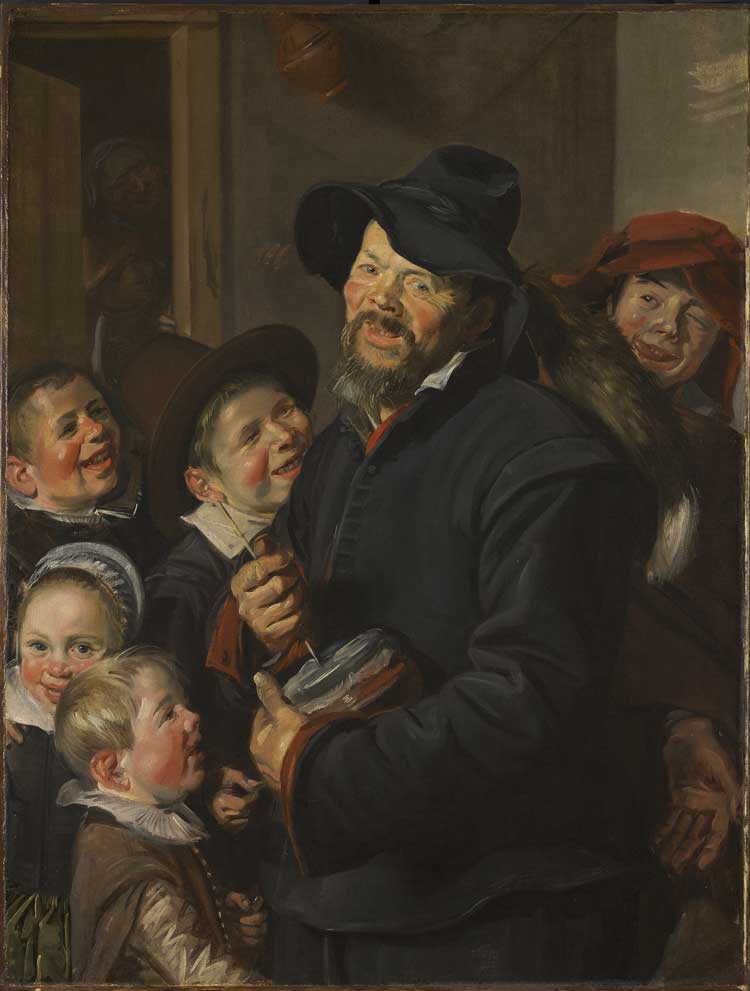
Frans Hals. The Rommel-Pot Player, about 1618–22. Oil on canvas, 106 x 80.3 cm. © Kimbell Art Museum, Fort Worth, Texas.
Rooms four and five concentrate on Hals’s genre pieces, which portray everyday life figures and “types”. For example, we see The Rommel-Pot Player (c1620), with his self-fashioned instrument made from a pig’s bladder stretched over a jug with an inserted reed, which made a horrendous squealing noise and, as evidenced here by the impishly grinning mob surrounding him, was much loved by children. Hals’s tremendous ability to capture his sitters and characters laughing, grimacing and showing their teeth is a rare, if not unparalleled skill in the history of art.
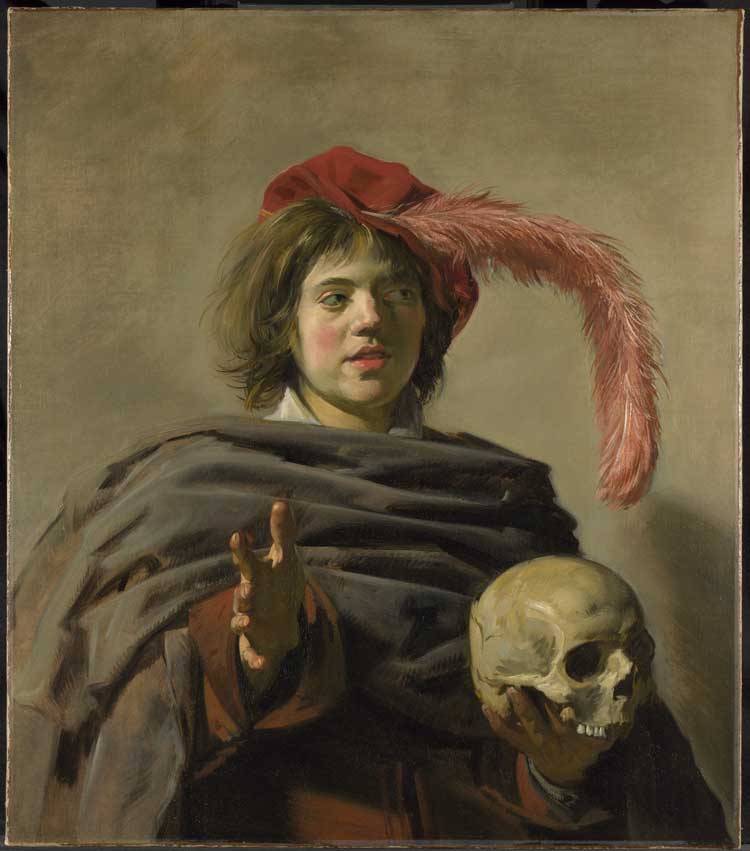
Frans Hals. Young Man holding a Skull (Vanitas), 1626-28. Oil on canvas, 92.2 x 80.8 cm. © The National Gallery, London.
Then there is the National Gallery’s own Young Man Holding a Skull (Vanitas) (c1627), which not only demonstrates fantastic foreshortening of the sitter’s outstretched hand, but brushwork so loose that the ground remains visible through the folds in his throw. These genre pieces had the advantage, through not being commissioned and the artist not therefore beholden to the wishes of a patron, of offering scope for daring experimentation and development of style.
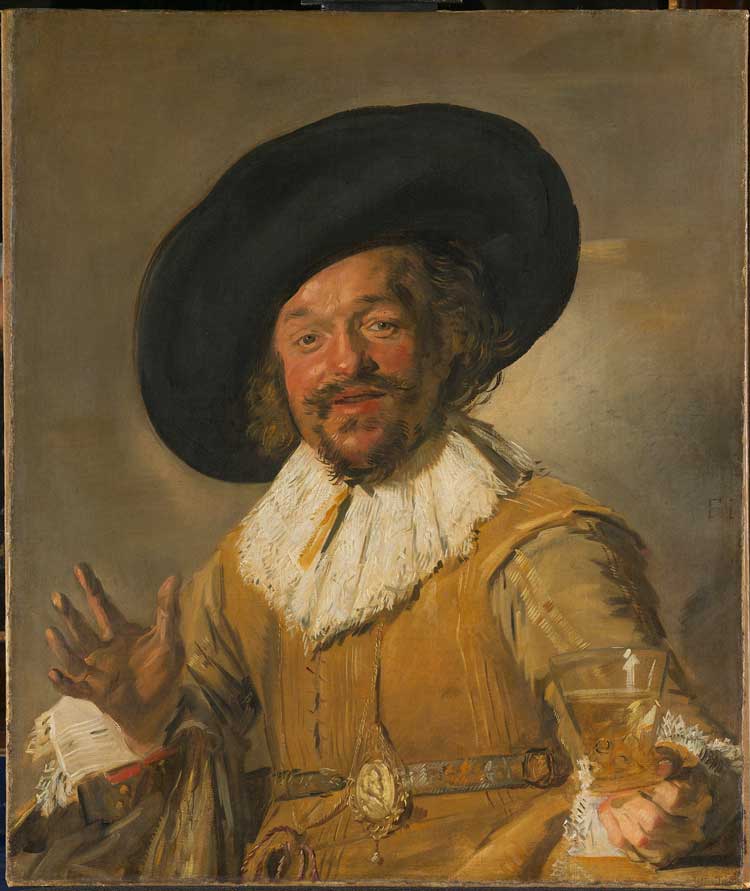
Frans Hals. A Militiaman holding a Berkemeyer, known as the ‘Merry Drinker’, c1629. Oil on canvas, 80 x 66.5 cm. © Rijksmuseum, Amsterdam (SK-A-135).
Another genre work – although it is thought possibly to have been a portrait commission – is A Militiaman holding a Berkemeyer, Known as the “Merry Drinker” (c1629). It depicts a red-cheeked caricature of a stock character found in 17th-century comic plays – a gluttonous buffoon whose diet of salted herring give him an insatiable thirst (for beer). Again, there is technical expertise in the foreshortening of the right hand, as well as in the rendering of the beer glass, with a slash of white paint capturing the refracted light.
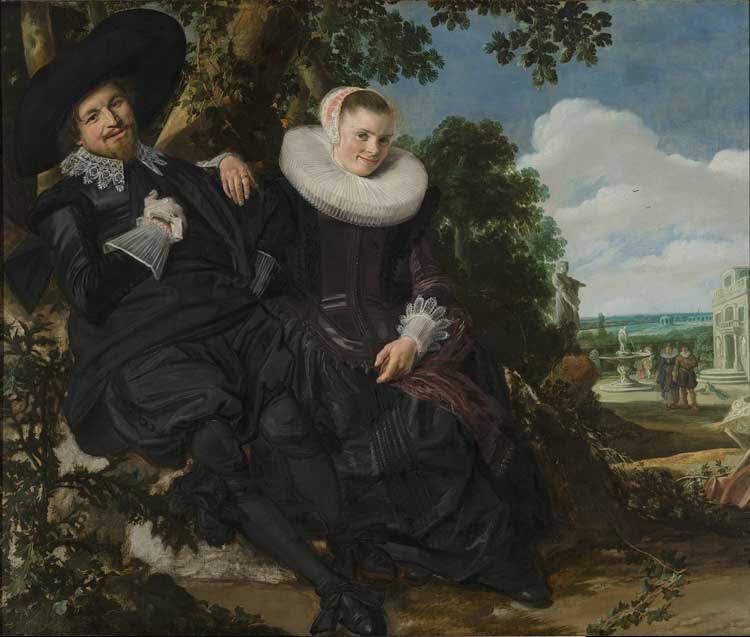
Frans Hals. Portrait of a Couple, probably Isaac Abrahamsz Massa and Beatrix van der Laen, about 1622. Oil on canvas, 140 x 166.5 cm. © Rijksmuseum, Amsterdam.
Room six is called Family Ties and includes family group portraits as well as some more individual portraits, pushing the boundaries of informality in gesture, both of the subject and of the mark-making. There are three portraits of Hals’s friend Isaac Abrahamsz Massa: two alone and one together with his wife – Portrait of a Couple, probably Isaac Abrahamsz Massa and Beatrix van der Laen (c1622) – in which she is showing off her wedding ring, and the vine behind them symbolises fertility. The solo portrait from the same year, using an oval “porthole” composition (something that was to become very popular with Rembrandt), is especially interesting. When it was being cleaned for the exhibition, some underpainting became discernible at the top right. An infrared scan revealed a woman and a skull, representing envy and the idea that death conquers this, which had been painted out early in the painting’s life, most likely still in the 17th century, but probably not by the hand of Hals as the brushstrokes are too even. Massa had apparently believed that he was being pursued by jealous men, and so his defiant pose, with his arms crossed in front of his chest, which has been the cause of much speculation over the years, is now understood to be a defiant pose against envy.
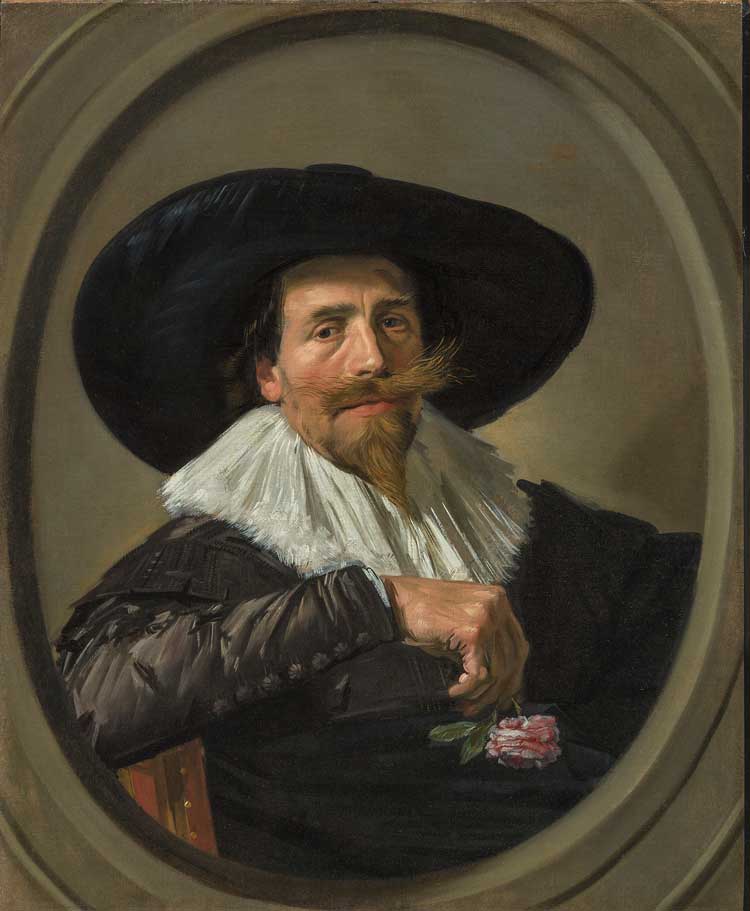
Frans Hals. Portrait of Pieter Dircksz Tjarck, about 1635–38. Oil on canvas, 85.3 x 69.9 cm. Los Angeles County Museum of Art. Gift of The Ahmanson Foundation. © Los Angeles County Museum of Art, California.
Another discovery through this exhibition is the reuniting of a further pendant portrait pair: Pieter Dircksz Tjarck (c1635) and Marie Larp (c1635). Their union has previously been disputed, as the ovals of their compositions do not entirely match, but their common provenance now confirms the hypothesis that they belong together. (As a side note, women in 17th-century Netherlands kept their own surname after marriage.)
There are also two large family portraits on display in this room, which are interesting in as much as the figures look almost like cutouts, superimposed on to the bucolic landscape. In fact, this is almost the case, since the landscapes would probably have been painted by someone other than Hals, leaving him, the master, to focus on the portraits, which were his speciality.
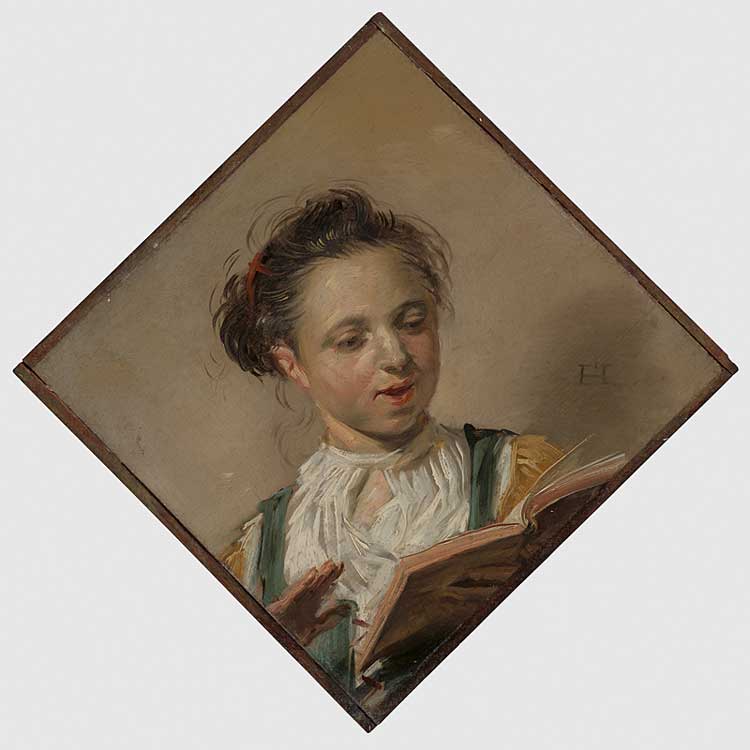
Frans Hals. Girl Singing, 1625–30. Oil on panel, 20.3 × 20.3 cm. The Jordan and Thomas A. Saunders III Collection, on loan to the Virginia Museum of Fine Arts. © Virginia Museum of Fine Arts.
Room seven is a small side space showcasing some charming little gems, including two diamond-shaped portraits in tortoiseshell frames – Girl Singing and Boy Playing the Violin (both c1628) – which I and an artist friend, who was visiting at the same time, imagined would be perfectly suited for a predella panel, with one of the larger family groups as the central – lay – altarpiece.

Frans Hals. Portrait of Jasper Schade, 1645. Oil on canvas, 80 x 67.5 cm. National Gallery Prague. Photo © National Gallery Prague 2023.
The final room of the exhibition focuses on Hals’s late works. From the 1640s on, at the height of his success, he concentrated solely on commissioned portraits, leaving his genre painting behind him. Portrait of Jasper Schade (c1645) – note the flat collar – depicts a known dandy and arrogant bachelor (could that arched eyebrow be more condescending?). Apparently, Schade’s uncle wrote a letter to his son, warning him not to spend too much on extravagant clothing like his cousin, who had been to Paris and run up huge tailor’s bills. The grandiosity of the jacket is rendered by Hals’s applying a greyish-yellow paint, wet on wet, on to a black undercoat, so that the colours mingle a little, suggesting the sheen of silver embroidery. The shadow on the darker, flatter underside of the sleeve is also remarkably executed, doubtless influenced by the master of chiaroscuro, Caravaggio. It is Portrait of an Unknown Man (1660), however, that really represents the apogee of Hals’s loose brushwork.
Despite having earned a reputation as something of a virtuoso, never needing to make preliminary sketches, Hals nevertheless struggled financially. Finally, from 1661 onwards, he was exempted from guild contributions and, the following year, was granted a lump sum payment and yearly pension by the Haarlem authorities. Hals lived into his 80s and painted until the end of his life.
Despite his later loss in favour, as public taste began to prefer portraitists influenced by Van Dyck, Hals, as noted earlier, regained popularity in the late 19th century, and Vincent van Gogh considered Hals’s worth to be greater than Michelangelo’s, Raphael’s and that of all the masters of antiquity. He wrote to a friend in 1888: “[H]e painted portraits; nothing, nothing, nothing, but that,” going on to enumerate his many subjects. Certainly, I left this exhibition feeling that, as thoroughly as I had considered each example of Hals’s work, so had each figure thoroughly observed me from the confines of their frame. Whether or not he is laughing, The Laughing Cavalier remains my metonym for the works of Hals, since it is this capturing of character and expression, and his outstanding ability to render embroidery and lace, that will be my lasting memory of this retrospective.